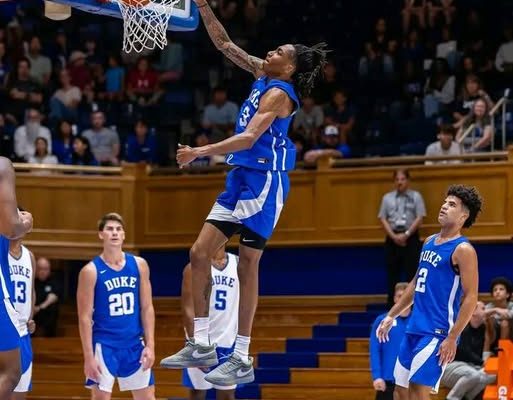They made one coaching adjustment this summer, and now Duke’s entire offense looks like a different beast. Fans, analysts, and even rival programs are starting to take notice—and some are saying it’s the most dangerous the Blue Devils have looked in years. What’s wild is that the transformation didn’t begin with a flashy recruit or a viral video from training camp. It started with a quiet, almost unnoticeable coaching staff change. No headlines, no fanfare—just one strategic hire behind the scenes. But that move has sent ripple effects across the entire offensive identity of the Duke football program.
The change came in the form of hiring Malcolm Koonce as the new offensive analyst—an off-field role that typically doesn’t grab headlines. Most fans didn’t even know who he was at first. Koonce, previously a passing game analyst at a Group of Five program with a reputation for developing efficient air raid systems, was brought in as a consultant to rethink how Duke approached offensive spacing, tempo, and quarterback reads. And in less than one offseason, Duke has gone from predictable to potent.
During spring ball and through early fall camp, coaches started leaking just how drastically different this year’s offense looked in practice. Faster tempo. More play-action from under center. More pre-snap motion. But it wasn’t until the first closed-door scrimmage that word began to spread internally: this isn’t last year’s offense anymore. And once fans caught glimpses during the Blue-White scrimmage, the murmurs turned into full-blown hype. Players looked more decisive, the playbook seemed deeper, and the rhythm was undeniable.
The secret sauce? Koonce helped install a hybrid approach blending west coast timing concepts with vertical spread principles, allowing Duke’s quarterbacks to process faster without sacrificing the chance to strike deep. The Blue Devils are now using a lot more “option routes”—routes where receivers adjust based on coverages on the fly—which requires high-level communication but also creates havoc for defenses trying to predict tendencies. Last year, Duke relied too often on basic route trees and struggled against zone-heavy teams. This year, they’re attacking seams, finding soft spots with surgical precision, and forcing defenses into mismatches they can’t scheme their way out of.
Fans have noticed something else too: the offensive line is playing with more confidence. The ball is getting out quicker. The run-pass balance has improved. One coach anonymously told a local radio show, “This is the most confident I’ve seen our offense look since I got here. It’s like we’re finally letting our guys play free.” That freedom is what’s catching people off guard. What once felt like a rigid, overly conservative attack has become a flexible, unpredictable, and, frankly, fun offense to watch.
Quarterback progression has also taken a leap forward. Duke’s starter—who last season was solid but not spectacular—looks like a totally new player. It’s not just about better mechanics or decision-making, though those have improved. It’s the way the entire offense is designed now to give him clearer reads and better mismatches. In short, the scheme is quarterback-friendly in a way that allows for both high-percentage throws and deep-shot opportunities. You’re seeing quicker feet, faster progressions, and far fewer moments of hesitation. When you combine that with the tempo increase—Duke is now snapping the ball 3-4 seconds faster on average per play—the defense simply doesn’t have time to settle.
This all feeds into the biggest intangible: confidence. Wide receivers are now being put in motion to create leverage. Tight ends are becoming legitimate weapons on misdirection plays. Even the running backs are catching more passes out of the backfield and being used creatively in screen sets and wheel routes. The entire offense has shifted from reactive to proactive. They’re not just taking what the defense gives them—they’re dictating the terms of engagement.
It would be easy to credit this change to a head coach overhaul or a new offensive coordinator, but that’s what makes this story so unique. The primary leadership didn’t change. The philosophy didn’t swing wildly. Instead, it was a subtle redirection. A willingness to listen to outside input. Head Coach Mike Elko has been praised quietly within the program for allowing new ideas to influence the game plan, even if those ideas didn’t come from the top of the food chain. That’s leadership rooted in humility—and it’s paying off.
Insiders say Koonce spent the early summer locked in film rooms, breaking down successful NFL and college systems, and tweaking Duke’s offensive scripts at the micro level. One wide receivers coach described him as “obsessed with the smallest details that change everything.” For instance, Duke added more condensed formations and tight splits, forcing defensive backs into traffic and making it harder to press or jam at the line. That change alone has freed up key playmakers who last season struggled to find space against physical man coverage.
Another big shift came with how Duke now attacks the middle of the field. Last year, the offense avoided that space far too often. Now, with high-low reads and layered route combinations, the area between the hashes is a feeding ground. The tight ends are feasting on mismatches, and the safeties are being pulled in two different directions on nearly every snap. Linebackers can no longer play downhill without risking being torched over the top. The offense has gone from two-dimensional to multi-layered, and it’s made every single position group better by extension.



